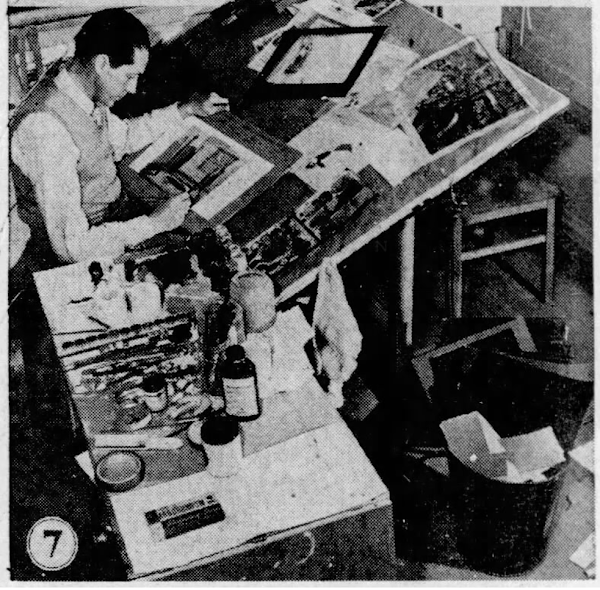There may be more information available from the past about animators and animation studios than ever before, thanks to the internet. Some of it is even free.
Unfortunately, some of it isn’t in the best of quality. One example is old newspapers. Their source may be scans of microfilm, which are photos of newspaper pages. Resolution was pretty poor way-back-when (I started researching through old papers in the late 1970s and the microfilm was pretty beat up back then).
That brings us to this post, which is a transcription of a full page article in the Nov. 16, 1946 edition of the Valley News, embracing the San Fernando Valley. The paper loved profiling its celebrity residents and one was Walter Lantz. The News had several stories about him that year, but this one looked at his studio and how it made cartoons. Unfortunately, the photos—which I suspect were supplied by Walter Lantz Productions—reproduced below are not too viewable. But you can get a bit of an idea of how things were done.
You can chuckle at the insistence that cartoon characters don’t go strike, and so on. It’s a cute statement, but doesn’t take into account the people who made the cartoons could strike. Ask the other Walter. And the idea Lantz “created” Krazy Kat or the Katzenjammer Kids is an engagement in semantics.
Picture one shows Bugs Hardaway at the right; whether that’s Milt Schaffer at the left, I don’t know. Picture 2 shows Dick Lundy. Picture 7, I guess, is Fred Brunish. It certainly isn’t Terry Lind.
Woodpecker And Panda Amuse All
There are some movie stars who are never tempermental [sic], indisposed, or suffering from contract trouble. They are not concerned about strikes or picket lines. They even work through fire and water, and they provide diversified and invigorating entertainment for millions of movie fans.
Some of these popular and indestructable movie stars perform for Walter Lantz at his studio in Universal City. Walter located there eighteen years ago and in the interim he has created, among others, such intrepid performers as “The Katzenjammer Kids,” “Maude the Mule,” “Krazy Kat.” His latest creation shows “Andy Panda” and “Woody Woodpecker” in Chopin’s Musical Moments, combining some of the world’s best music, cinema art and animation. The negative cost alone of this production was $50,000 and 25,000 drawings were used. In silent days about 2500 drawings were used and the negative cost was about $3000.
Walter and 22 of his employees live in the Valley and some of them have been in this area long enough to witness sensational developments in their business and the communities in which they live. These Valleyites include such luminaries as Darrel Calker of North Hollywood, Ben “Bugs” Hardaway of North Hollywood, and Fred Brunisch [sic]. Calker is the musical director and a well-known composer-arranger. His “Penguin Island” was performed at the Hollywood Bowl, and he was one of Andre Kostelanitz’ arrangers when the conductor’s style was first set. Hardaway is recognized as one of the best sketche[r]s of a cartoon story in the business. He created the present day character, “Bugs Bunny,” and many others. During World War I he served with President Truman in the Field Artillery. Brunisch, background artist, is a prominent California portrait painter and scenic artist.
Thirty years ago Walter, at the age of 18, quit his job as an assistant artist for the New York American to become Gregory La Cava’s assistant in a new enterprise, motion picture cartoon business. Greg at that time was a well known newspaper cartoonist; today he is one of Hollywood’s top directors. Their productions have proved an important, artistic and entertaining part of the entire motion picture industry, and their characters have helped to alleviate the worries of millions of people in all parts of the world.
Of the original group of men who entered the intricate cartoon industry, Lantz is tbe only one who stayed long enough to become a producer and continue in the animated business. He still sketches and takes an active part in every phase of Walter Lantz productions. Every afternoon he spends at least an hour or two “in the back” of the studio, sitting in story conferences, chatting with background artists, watching animators, or helping in the cutting room.
Today, as president of the animated cartoon producers associaition, Lantz has the admiration and respect of everyone in the business. He knows all there is to know about the business at present, but that does not stop his continual research and experimentation.
1. The story department at Lantz Productions. Writers dicussing a scene from a musical picture, where action must be made to fit the music.
2. When the script is completed the director analyzes each picture to see if additions or deletions are necessary. The long sheet he is using gives full details on the particular sequences of the film it explains.
3. The layout man gets the sequence next, and he works out such important details as close-ups, medium, and long-shots.
4. All drawings are pencilled on celluloid; key drawings are made by the animator while assistants do fill-ins.
5.
The inkers go over the animator's work.
6. She colors the inked drawings. Large number of jars contain carefully blended paints.
7. The animator creates action for the film while another artist paints backgrounds.
8. The checker examines each drawing for mistakes. Too few drawings will result in jerky movements of the characters.
9. For the finished motion picture animated cartoon a special type of camera is used. Frame by frame the picture is photographed.
10. "Dubbing in voices and recording the music. Musical Director Darrell Calker conducts the orchestra. Recording for cartoons is tricky business.
11. Job of the film cutter is to assemble sound, music, and picture tracks, make them one.
12. Producer Walter Lantz gives the picture a final once-over.














No comments:
Post a Comment